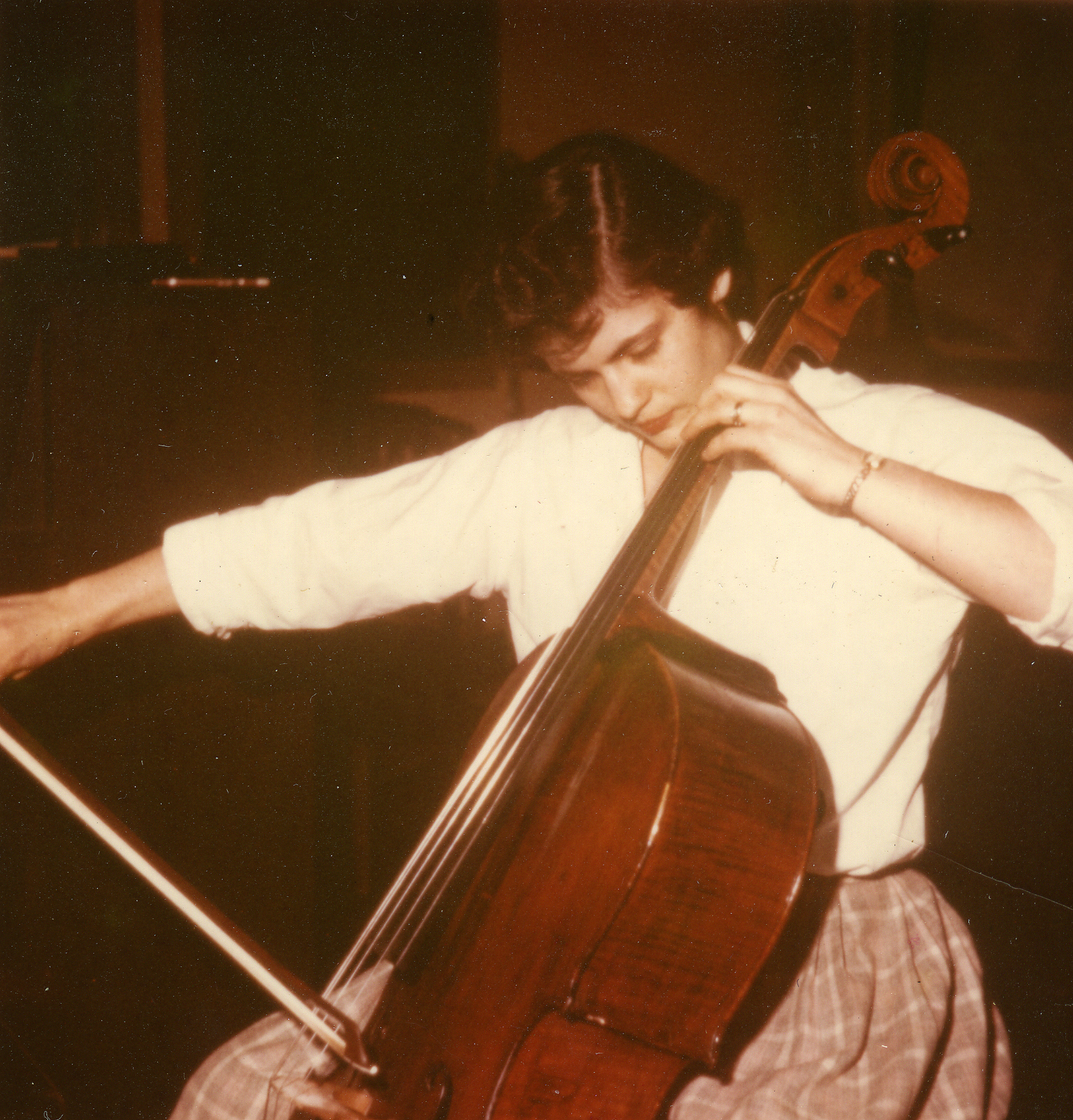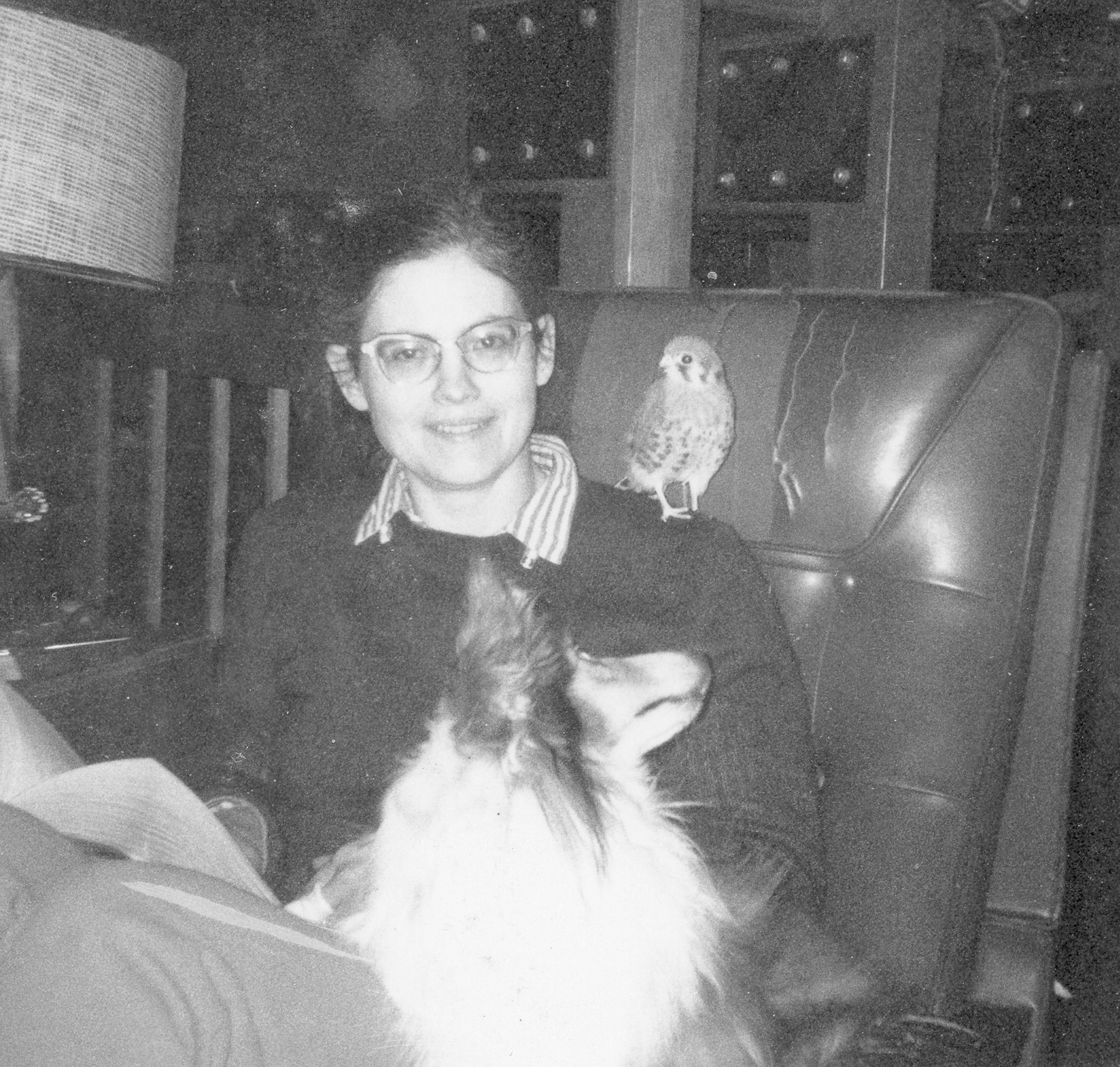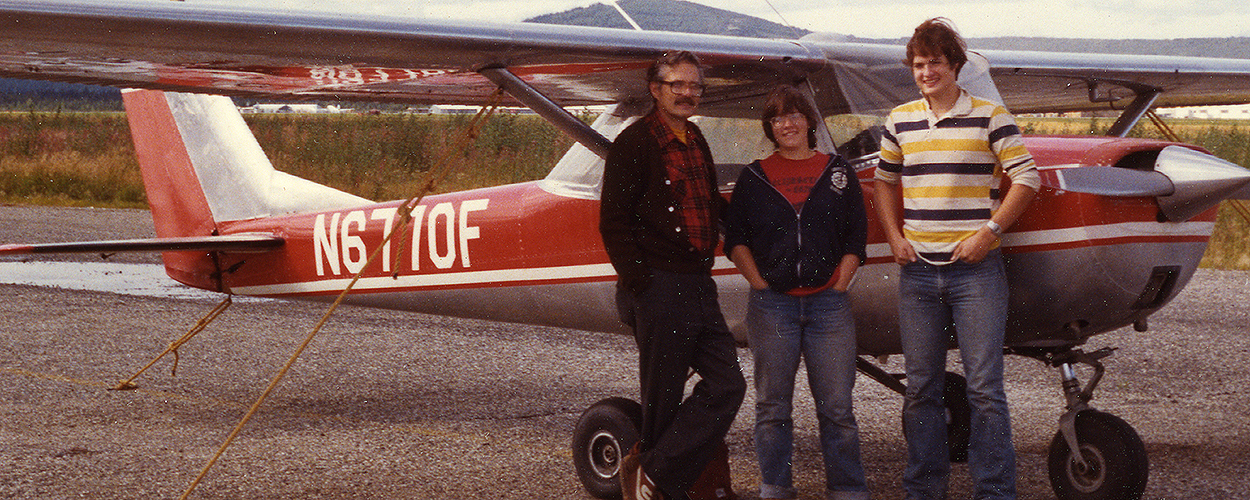Photo courtesy of Peggy Swartz.
Jerry Swartz holds a red-tailed hawk in 1977.
By Karen J. Tomasik

Peggy Swartz cooks food next to her and Jerry’s car about 30 miles north of Dawson Creek while on the couple’s honeymoon trip, moving to Alaska in 1958.
From a young age, Leslie Gerard Swartz, “Jerry” to most who knew him, liked the outdoors, animals, birds and plants.
“Chicago has a very large area set aside as forests and he spent a lot of time in those woods ever since he was very young,” explained Peggy Swartz, who met Jerry when they were both graduate students at the University of Illinois at Champaign-Urbana.
Although Jerry and Peggy pursued studies in different disciplines, they both shared a love of being out in nature. They married on Jerry’s birthday in 1958 and drove to Alaska on their honeymoon.
“He never really had much doubt about what he wanted to do for a career,” said Sue Mitchell ’91, the Swartz’s oldest child. “He went through [school], got his Ph.D., got a job at the university and that was it. I used to kind of envy him because he always knew what he wanted to do.”
Peggy attributed the start of their permanent stay in Alaska to inertia.
“We liked Alaska. The people here were good and we felt kind of at home here,” Peggy explained. “Jerry was interested in the countryside and the possibilities and the biology, and for me, there was an interest in music also that was attractive. We stayed, except for a couple of years when we did sabbaticals.”
Inspiring others to pursue lifelong learning was something Jerry and Peggy shared with their immediate and extended family members. Before Jerry died in November 2023, they established the Gerard and Peggy Swartz Biology Endowed Scholarship, which provides financial assistance to students pursuing a bachelor’s or graduate degree from the UAF Department of Biology and Wildlife.
The Swartz’s early years were full as they worked together to build an A-frame house on Yankovich Road where they lived until 2021. They had four children: Sue, twin boys Roger and David born three years later, and Judy, who was born in 1968.

Jerry works on the A-frame home’s basement under construction in the summer of 1962.

Peggy peels logs for the house on Yankovich Road during the summer of 1962.

An early photo of the A-frame house the Swartzes built on Yankovich Road.
A home for learning

Jerry Swartz works in a lab in the Bunnell Building at UAF.
Anyone who has been around a young child knows how inquisitive they can be, and with four children in a household, Jerry and Peggy fielded many questions over the years.
“When we were growing up, we would ask Dad ‘What does this word mean’ or ‘How do you spell it’ and he’d say ‘Look it up,’ and he’d pull out a dictionary and have us look it up,” Sue recalled. “He taught us how to find out for ourselves.”
Jerry’s students would run into one of the Swartz children and, after learning who they were, would often comment on how Jerry would grade on English because he said scientists should know how to write.
While Jerry’s focus was on biology and teaching, Peggy performed and taught music. She was one of the founders of the Fairbanks Symphony Orchestra and played in the symphony and in the Arctic Chamber Orchestra for decades.
“I was one of the first ones in the fledgling symphony and helped found the youth symphony and the North Star Strings,” said Peggy, who later started the Suzuki program for children in Fairbanks and taught private lessons for years.

Peggy Swartz plays the cello.
The A-frame on Yankovich would be filled with much more than just young musicians and the Swartz children; it was also home to a variety of pets.
“We would gather any kind of animals, and Dad encouraged and helped us,” Sue said. “Any kind of animal that we came across that we wanted to bring home and keep as a pet was fair game.
“We had rats and guinea pigs and gerbils and of course dogs. I had a horse, my sister had a horse, and we had a couple of small alligators, snakes — just pretty much anything, even water beetles, frogs and stuff we would go catch at Smith Lake near the university.”
One family pet preferred family life on its own terms.
“We had a flying squirrel for a while that started as a pet and quickly got loose and lived inside the house,” Sue explained. “In the evenings after dark, it would glide down into the living room and sometimes land on somebody’s shoulder. Mom would leave food out on the counter for it, and it would come drink out of the dripping faucet.”
As the Swartz children grew up, they got to know some of Jerry’s graduate students, even keeping in touch with them well after they graduated and moved on to their own careers.

Puuka, the Swartz’s first dog after arriving in Alaska, stands on her doghouse with Sue (in front) and younger brother Dave during the winter of 1967.

Peggy Swartz pauses from reading a book with family dog Holly on her lap and Snapdragon on her shoulder. Snapdragon was a kestrel that Jerry and Sue raised and trained one summer and that lived mostly in the house.
An extended family
“Ron [Clarke ’84] said we were like his family,” explained Sue. “Dad involved his grad students in our lives. They came for holidays. Lived next door in some cases. They were a very integral part, not just at school, but in our lives. And sometimes they pulled pranks on him and us.
“One day I remember a couple of the grad students came over and they had this big trash can. They said, ‘This is a pet for you kids. It’s not for Jerry. It’s just for you kids; it belongs to you, and you can decide what to do with it. Jerry doesn’t have anything to say about this.’ We said ‘Oh good, good, great, great, great,’ we were so excited. They opened the lid and there’s a live porcupine in there! We agreed that perhaps we could let that one go.”
Jerry specifically wanted to teach freshman biology because he wanted to get students early, but he also spent a lot of time working with various graduate students over the years. For Clarke, Jerry made the difference in his ability to complete his master’s degree.
“I planned to study merlins, a small species of falcon, for my research,” Clarke explained. “I went to go play a pickup sandlot football game outside the Patty Center and I injured my knee. So here I was with an ankle-to-hip cast for nine weeks as field season was starting.
“As luck would have it, Steve MacLean had a field ecology class going on at that time, and the class was getting attacked by a sharp-shinned hawk. Jerry had me come out with him to search the field for the nest the hawk was protecting, and we built a blind.
“I was able to watch the brood get raised, and I was able to use that for my master’s thesis,” Clarke said. “That was just my first summer of research, but I met my best friend Bill Tilton, who taught me even more about how to find those nests, and I got three more field seasons in. Bill was a UAF art student, but also a very talented naturalist and a falconer.”

Jerry Swartz, left, and Ron Clarke each hold a red-tailed hawk, while Fairbanks wildlife artist Randall Compton, right, holds a female goshawk during a field outing in 1977.
Clarke, Tilton and Alan Springer ’74, ’88 were part of a group of graduate students who would go to the Swartz home for Thanksgiving every year.
“Mom would bake the biggest turkey she could find; they were often close to 40 pounds,” Sue said. “She would feed all these grad students of Dad’s and they would compete to see who could eat the most.”
“They had this great big door they put up on sawhorses and put a tablecloth over it,” Clarke explained. “That makeshift table could seat 14 people.”
The holiday meals led to some lasting connections for the Swartz family.
“There were a bunch of really nice students — we really enjoyed knowing them,” said Peggy. “Of course, they often couldn’t go home for Thanksgiving, especially in the earlier days when flying wasn’t quite as easy to do. So we would invite them to come over and have Thanksgiving, and they kind of became parts of the family. Many of them I’m still in touch with today.”
“At my wedding, Ron Clarke, Alan Springer and Bill Tilton had been out hunting with their falcon that day and they came to the reception at Raven Hall out in Goldstream Valley with the tiercel gyrfalcon and a dead white-fronted goose,” Sue explained. “They visited with Dad and showed it to him because they were so proud that their bird had brought down this goose, which is a really big prey for the smaller male bird. So there’s a picture of my dad sitting there wearing a tuxedo with a gyrfalcon on one hand and the goose in his other hand.”
Birds bring family together
Working with birds of prey was a passion of Jerry’s, so much so that a significant study of his centered on successfully raising peregrine falcons in captivity.
“This was when peregrines were endangered because of DDT. They would absorb it into their tissues and it would build up,” Sue explained. “One of the effects was that the eggshells would get thin and the parents would break the eggs just by sitting on them. He was trying to find ways to breed them in captivity for release in the wild to help boost the population.

Snapdragon, Jerry and Sue's kestrel, was the only bird allowed to fly inside the house.
“I think somebody at Cornell was the first, but Dad, if I’m not mistaken, was the second one to ever succeed in doing that.”
Jerry built an outbuilding for the peregrines in what the family called the hawk house.
“He had a baby monitor so that he could listen to what was going on when we were in the house; you could hear what was going on out in the hawk house,” Sue said. “Sometimes he’d tell us all ‘Stop, be quiet’ so he could listen to the calls and what’s going on.”
Sue recalled that Jerry would sometimes run out to the hawk house and peer through a little one-way glass window to observe the birds if things sounded promising. His work was to get the amount of light and conditions right so the falcons would breed, and he could then take the eggs and put them in incubators to raise them.
“When they hatched, he had a peregrine puppet he had made, so that he could feed them,” Sue said. “The chicks would imprint on what they saw, and he didn’t want them to imprint on humans; he wanted them to imprint on peregrines, so he made this very realistic peregrine puppet with an operable beak so he could feed little bits of meat to the babies with the puppet.
“He really took very good care of those birds and was always trying to find food for them. We would come to a screeching halt on the road if we saw a fresh roadkill, and he would pick it up and throw it in the back of the VW bug. He raised Japanese quail in the garage to feed the falcons.
“He did chickens too, so for at least two or three years he would get about 900 baby chicks in the spring, and he would put them in my horse barn over the summer. The horse had to go out in the corral for the summer, and the chicks took over.
“He often got things from trappers; we’d come home and there’d be a skinned wolverine on the kitchen counter thawing,” Sue explained. “It was an interesting way to grow up, and I used to have to warn my friends if they were gonna come over and visit that there might be something weird on the kitchen counter. He’d put this stuff in the chest freezer next to the berries and the moose meat or the casseroles that Mom had made. Dad would leave some whole animal on the kitchen counter to thaw because you can’t microwave it to thaw it for peregrines. They don’t like cooked meat. So I might bring my friends home from school and there’d be a dead animal lying on the kitchen counter. This was normal to us, but we had to remember to warn new friends not to freak out.
“Every now and then he’d forget to take something out of the freezer in time so he would put it in the oven on low to thaw it a little faster,” Sue said. “There was a memorable incident when I decided to make cookies and turned the oven on preheat without checking inside. Nobody was happy that day. It was a baked rat. Mom wasn’t happy. Dad wasn’t happy. And I wasn’t happy.”
From falcons to aviation
Their son Dave, wanted to become a pilot, partly inspired by the flight of the falcons his Dad raised. Through Dave, Jerry became interested in aviation.
“We kids were mostly grown when Dad took up flying. He and Mom flew all over the Lower 48 a total of 12 times,” Sue explained. “Once they went out to Chicago and picked up my grandfather, Dad’s father, and flew him to Georgia to visit Dave there and then flew him back.
“I used to joke that some people retire, and they get a Winnebago, but my parents got a Cessna,” Sue said with a laugh. “They would just land someplace and pull out a tent and sleep beside the runway, or else somebody would offer them a place to stay, or they’d catch a ride to town and stay at a hotel. They had a good time doing that.
After his retirement, Jerry bought a kit to build an RV9A, an experimental airplane that carries two people. Over about a decade, he built the kit and finally flew it at the age of 89.
“My brother still flies regularly; he still has the plane that Dad built,” Sue added. “His daughter, just this summer, soloed in that plane, so she’s learning to fly using that plane.”

Jerry Swartz stands with his daughter Judy and son Dave in front of a Cessna 150, the first plane Jerry bought. It was later replaced with a Cessna 172, whose engine Jerry overhauled.
As parents, Jerry and Peggy’s interests likely influenced their kids.
“I was the black sheep who didn’t learn how to fly and didn’t learn music,” Sue said. “Mom tried to teach me for a while, but it didn’t work. My sister Judy still plays; she plays in the Mat-Su Orchestra and still enjoys it.
“[Dad’s] love of language might have influenced me going into my profession, that interest in language. Respect for language,” Sue explained. “I was involved with communication and writing and publications for my whole career, and I had a degree in English from the University of Hawaii. And I’ve always also been interested in the natural world and especially animals. I enjoy seeing wild animals when I’m traveling. That’s what I go to do; see the creatures and nature.”
Learning of and making an impact
One former student, Ron Fayer ’62, was inspired to establish a scholarship in Jerry’s honor. Fayer attended the 2023 Nanook Rendezvous reunion and, while there, inquired about Jerry with UAF development team member Judy Dellinger ’93.
Dellinger reached out to Jerry for permission to share his contact information. When the two men met, Fayer recounted how memories of his professor had energized him to create a UAF scholarship.
That influenced Jerry and Peggy to do the same. They talked to Dellinger about a $30,000 gift to establish the Gerard and Peggy Swartz Biology Endowed Scholarship. After Jerry moved into an assisted living facility, they decided to increase the gift to $100,000.
“We wanted to put some money in a place where it would do some good,” Peggy said, “and both of us of course are very much interested in education and feel the future of the world is in the children and young people.”
Jerry passed away on Thanksgiving.
As Jerry spent his final time with family, he was visited by several graduate students and friends from various locations, including North Pole, Chickaloon and Seattle.
“When Ron [Clarke] drove up from Chickaloon and asked Dad if there was anything he wanted in his final days or weeks, Dad said ‘Well, I’d really like to have a peregrine on my arm again,’” Sue said, “and Mom kinda shook her head and said ‘No, that’s not gonna happen.’ When I saw Ron over lunch later, I said ‘You should totally do that.’
“So, a few days later Bill Tilton brought a peregrine into the assisted living in the evening, and we have pictures of it sitting on Dad’s arm in the bed,” Sue said. “The owner of the assisted living thought it was really cool because she got to touch a peregrine, and she never would have had that chance otherwise.”


